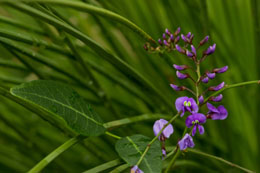The wisteria plant is popular in decorating your landscape area with showy and fragrant blossoms. Read on to know more.

With its green foliage, fragrant purple blossoms, and a moderate amount of brown fruits, the wisteria plant is hard to miss, mainly during the spring season.
Generally described as a perennial vine, these trees or plants grow mainly in the United States, their native land. These plants have a comparatively longer life span than most of the plants belonging to the same species. Also, the plant has a rapid growth rate, with the mature varieties growing up to the height of 50 feet.
Plantation
- First you have to decide the location. Choose places near ponds or any other water bodies, as they will help in its growth.
- Dig a hole which will be as deep as the root ball of the plant and three times as wide.
- Put the root ball into the hole. If you are planting more than one plant, then keep them at a distance of 10 feet.
- Now fill the hole halfway with soil and water. This is done to get rid of air pockets. Once the water drains out, fill the hole completely and water it once again.
- Every spring, introduce some compost at the base of the plant. Put the amount required in order to control the growth of weeds and conserve the moisture of the soil.
- Early summer, when flower blossoms, prune the plant. The side-shoots which branch out from the main stem need to be cut off and their length should be kept at around 6 inches.
Proper Care
There are two main ways of caring for the plant - mechanical support and wisteria pruning.
Mechanical Support
These plants are wall climbers and they grow up to a height of nearly 15 meters, and spread up to nearly 40 meters. Therefore they are extremely heavy as compared to others. Thus, one should focus more on the mechanical support and the infrastructure that will hold up the plant.
One method is threading a heavy gauge wire made of steel through the vine eyes and balancing it with strainer bolts. The entire support should be strong enough to balance your own weight. These plants, after blossoming, tend to gain weight. This task is done best during winter when the foliage does not impair your visibility. Check the wire at least once a year for rusting. Install new lines when needed.
Wisteria Pruning
Pruning should take place at least twice a year. The first pruning should be done during early spring. During this time, the plant may grow a number of long thin shoots, and if you want to replace an old branch, then you should carefully tie these young shoots as per the position you need. While cutting these shoots, be careful that you leave an inch or two of the stem, as this will encourage the growth of the new buds.
To extend the coverage of the plant, just tie the strongest shoots to the lines supporting the plant. Once you feel that your plant has covered the required area in your garden, you have to limit the growth of the plant, and also encourage the growth of the spring flowers.
Converting a green shoot which grows a meter every week, to a short woody flower spine, asks for regular attention, mainly during the month of July and August. If you ignore this for too long, then your plant will be nothing less than a tangled ball of wool. You will have a tough time tidying it up.
Make the first cut approximately six leaves away from the point of emergence of the new shoot. This cut need not be absolutely exact. Soon, you will have fresh growth from the shortened stub. You need to cut these within one or two leaf joints regularly.






 With its green foliage, fragrant purple blossoms, and a moderate amount of brown fruits, the wisteria plant is hard to miss, mainly during the spring season.
With its green foliage, fragrant purple blossoms, and a moderate amount of brown fruits, the wisteria plant is hard to miss, mainly during the spring season.